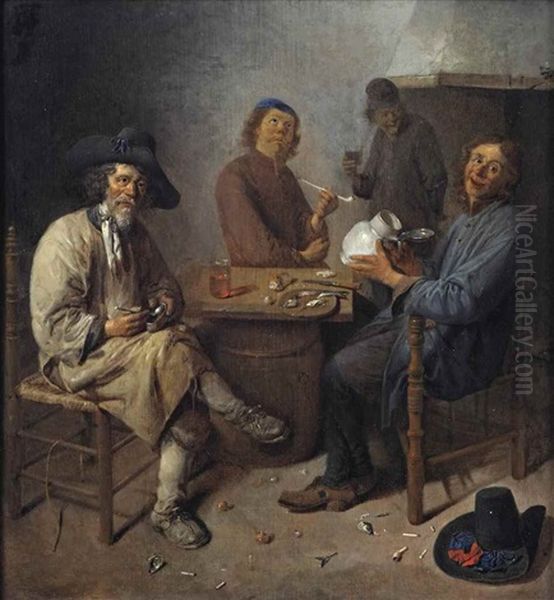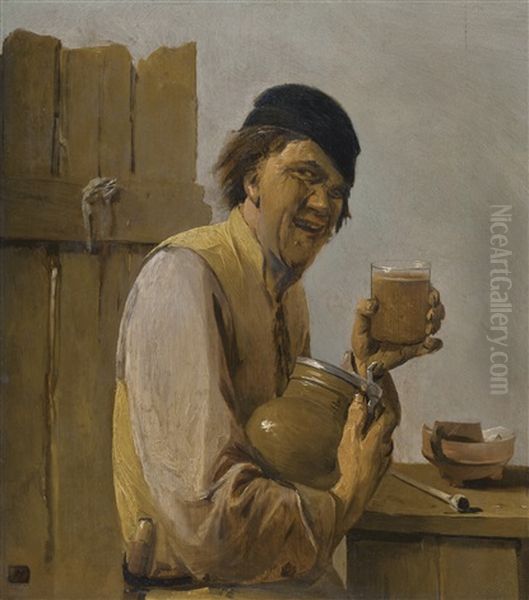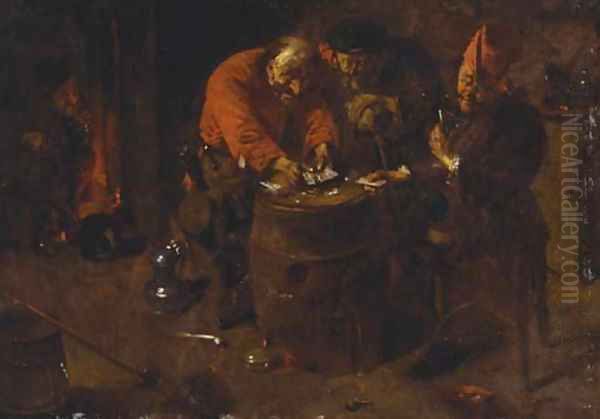Abraham Diepraam (1622-1670) stands as a notable, if sometimes overlooked, figure within the rich tapestry of Dutch Golden Age painting. Active during a period of extraordinary artistic output and innovation in the Netherlands, Diepraam carved a niche for himself with his lively and often humorous depictions of peasant life, particularly scenes set within the convivial, and at times raucous, atmosphere of local taverns. Though his technical finesse was occasionally questioned by later critics, his works offer a valuable window into the everyday social customs and popular pastimes of 17th-century Holland, capturing a spirit of unvarnished realism blended with a keen observational wit.
Early Life and Artistic Formation in a Flourishing Era
Abraham Diepraam, or Diepraem as his name is sometimes spelled, was born in Delft on January 23, 1622. Delft, at this time, was a bustling center of trade and artistic production, famously home to Johannes Vermeer later in the century. The artistic environment of the Dutch Republic was unique; with the decline of aristocratic and church patronage prevalent in Catholic Europe, a new market emerged, driven by a prosperous merchant class and affluent citizenry eager to adorn their homes with art that reflected their lives, values, and surroundings. This demand fueled the popularity of genres such as portraiture, landscape, still life, and, pertinently for Diepraam, genre scenes.
Diepraam's initial artistic training is recorded as being under Dirk Stoop, a respected glass painter. This early exposure to the intricacies of painting on glass, a medium requiring precision and an understanding of light and color, may have provided a foundational discipline. However, it was his subsequent association with the painter Adriaen Brouwer (c. 1605/06–1638) that would prove most formative for Diepraam's thematic and stylistic development. Brouwer, a Flemish artist who also worked in the Dutch Republic, was a master of low-life genre scenes, renowned for his expressive depictions of peasants carousing, brawling, and engaging in various vices in rustic interiors. Brouwer's influence on Diepraam is palpable in the choice of subject matter and the often-earthy realism of his figures.

It is also noted that in his youth, Diepraam studied alongside Willem Jansz van Stael, another figure associated with glass painting. This suggests a community of artists in training, sharing experiences and perhaps early influences. Diepraam is also said to have traveled to France at some point, a common practice for artists seeking to broaden their horizons, though specific details of this journey and its impact on his work are scarce. Upon his return to the Netherlands, he continued to hone his craft, eventually establishing himself as an independent master.
Guild Membership and Professional Career
A significant milestone in any 17th-century Dutch artist's career was acceptance into a Guild of Saint Luke. These guilds served as professional organizations that regulated the art trade, maintained standards of craftsmanship, and provided a framework for the training of apprentices. Abraham Diepraam became a member of the Guild of Saint Luke in Dordrecht in 1648. Dordrecht, an important trading city, had a vibrant artistic community, and membership in its guild would have allowed Diepraam to take on pupils and sell his work officially.
Some sources also mention an association with the Guild of Saint Luke in Amsterdam, though his primary and most clearly documented guild affiliation seems to be with Dordrecht. His pupil, Matthijs Wulfraet (1648-1727), later became a painter of genre scenes and portraits, suggesting Diepraam was an effective teacher, capable of passing on his knowledge. Arnold Houbraken, an important early biographer of Dutch artists, praised Diepraam as a good teacher to the young Wulfraet, whose works were reportedly easy to sell, particularly in Arnhem.
Diepraam's paintings, typically small in scale, found a ready market. He was known to depict scenes of peasants drinking, smoking, playing cards, or simply conversing in dimly lit tavern interiors. These works were popular for their narrative quality and their often humorous or moralizing undertones, which resonated with the Dutch burgher sensibility. There is evidence that Diepraam was commercially astute, at least for a time; for instance, he is recorded as having sold his works to Paris through the Pain et Vin company, indicating an international reach for his art. He also reportedly sold paintings directly in taverns, a practice that, while perhaps unconventional for some, placed his art directly within the environments he so often depicted.
Artistic Style, Themes, and Representative Works
Abraham Diepraam's artistic style is characterized by its focus on human interaction and the depiction of everyday life, often with a satirical edge. He followed in the tradition of Adriaen Brouwer and, by extension, artists like Adriaen van Ostade (1610-1685) and his brother Isaac van Ostade (1621-1649), who also specialized in peasant genre scenes. However, Diepraam developed his own distinct approach.

His early works often exhibit a finer brushstroke and a more detailed rendering, possibly reflecting his initial training. As his career progressed, his handling of paint sometimes became looser and more expressive. His figures, while not idealized, are imbued with a sense of character and animation. He had a keen eye for the telling gesture, the humorous expression, and the small details that bring a scene to life – a pipe, a tankard, a discarded card. His color palettes are often subdued, dominated by earthy browns, grays, and ochres, typical of tavern interiors, but enlivened by touches of brighter color in clothing or accessories.
One of his representative works, often cited, is Peasants Smoking and Drinking in an Interior. This painting, or variations on this theme, encapsulates his primary subject matter. Such scenes typically show a group of figures, often male, gathered around a table in a rustic setting. Some might be engrossed in conversation, others puffing on clay pipes, while some raise their glasses in a toast or succumb to the effects of alcohol. Diepraam was adept at capturing the various states of inebriation, from jovial camaraderie to sleepy stupor. These scenes were not merely documentary; they often carried implicit moral messages about temperance and the follies of excess, a common trope in Dutch genre painting.
Other works that exemplify his output include titles such as Tavern Scene, A Smoker, The Drinker, and Interior with Peasants. In these, Diepraam explores the social dynamics of the tavern, a central institution in 17th-century Dutch society. He often includes details like rough-hewn furniture, simple pottery, and the play of light and shadow to create a convincing atmosphere. While his figures are often caricatured to some extent, they retain a sense of humanity.
Diepraam and His Contemporaries
The Dutch Golden Age was populated by a remarkable constellation of artistic talent, and Diepraam operated within this vibrant milieu. His most significant artistic debt is undoubtedly to Adriaen Brouwer. Brouwer's innovative approach to peasant scenes, his expressive brushwork, and his psychological acuity set a benchmark that many, including Diepraam, aspired to or reacted against.
Beyond Brouwer, Diepraam's work can be seen in dialogue with other genre painters. Adriaen van Ostade, for example, also depicted peasant interiors, but often with a slightly more polished finish and a gentler, more harmonious mood than the sometimes-cruder scenes favored by Brouwer and Diepraam. Jan Steen (c. 1626-1679), another giant of Dutch genre painting, was a master storyteller whose lively and often chaotic scenes of everyday life, filled with proverbs and moral lessons, share some thematic ground with Diepraam, though Steen's compositions are typically more complex and his figures more individualized.

In Delft, where Diepraam was born, Johannes Vermeer (1632-1675) was creating his serene and luminous interior scenes, a world away from Diepraam's boisterous taverns, yet indicative of the diverse artistic production within a single city. Other Delft painters like Carel Fabritius (1622-1654) and Pieter de Hooch (1629-1684) were also exploring innovative approaches to light, space, and everyday subjects.
While Diepraam's focus was primarily on low-life genre, the broader artistic landscape included masters of other genres. Rembrandt van Rijn (1606-1669) in Amsterdam was revolutionizing portraiture and historical painting with his profound psychological insight and dramatic use of chiaroscuro. Frans Hals (c. 1582/83-1666) in Haarlem was renowned for his lively and spontaneous portraits that captured the sitter's personality with unprecedented immediacy. Landscape painters like Jacob van Ruisdael (c. 1628/29-1682) and still life specialists such as Willem Kalf (1619-1693) or Rachel Ruysch (1664-1750) were also pushing the boundaries of their respective fields.
The provided information mentions Gerard Seghers (1591-1651) and Daniel Seghers (1590-1661), who were prominent Flemish Baroque painters. Gerard Seghers was known for his religious and mythological scenes, often influenced by Caravaggio, while Daniel Seghers was a Jesuit priest and a celebrated flower painter, often collaborating by adding floral garlands around cartouches painted by other artists. While Diepraam's style and subject matter differ significantly from theirs, their contemporaneity and regional proximity (Flanders and the Dutch Republic had close artistic ties, exemplified by Brouwer himself) mean they were part of the broader artistic currents of the Low Countries. There is no specific record of direct interaction between Diepraam and the Seghers brothers, but artists were often aware of major figures in neighboring regions.
The artistic environment was one of intense competition but also mutual influence. Artists learned from each other, copied successful formulas, and strove to distinguish themselves in a crowded market. Diepraam found his niche by focusing on a specific type of genre scene that appealed to a particular segment of the art-buying public.
Critical Reception and Later Years
Despite the popularity of his works during his lifetime, Abraham Diepraam's artistic reputation has been somewhat mixed in subsequent art historical accounts. Some critics, particularly in the 18th and 19th centuries, found his brushwork to be overly loose or even careless, especially in his later works. There were suggestions, perhaps fueled by the subjects he depicted, that he sometimes painted while under the influence of alcohol, leading to a perceived lack of coherence or technical refinement. Arnold Houbraken, while acknowledging his talent, also recounted anecdotes of Diepraam's somewhat dissolute lifestyle, which may have colored perceptions of his art.
However, it's also important to consider that what was perceived as "loose" brushwork by some could also be interpreted as a deliberate stylistic choice aimed at conveying energy and immediacy, a characteristic also found in the work of highly esteemed artists like Frans Hals. Diepraam's ability to capture character and humor in his figures, and the narrative interest of his scenes, remained appealing. His works continued to be collected, and even in periods of economic prosperity, they commanded good prices.
The later years of Diepraam's life appear to have been marked by some hardship. The Dutch Republic experienced an economic downturn, culminating in the "Rampjaar" (Disaster Year) of 1672, when the country was invaded by France, England, and other powers. Although Diepraam passed away before this specific crisis, the preceding economic instability likely affected the art market and the fortunes of many artists. Despite the earlier success and sales of his paintings, he is reported to have faced financial difficulties towards the end of his life.
Abraham Diepraam died on July 16, 1670. Some records suggest he may have passed away in Rotterdam, though his primary associations were with Delft and Dordrecht. The exact date of his death is sometimes cited as July 14, 1670, indicating minor discrepancies in historical records.
Legacy and Historical Evaluation
Abraham Diepraam's legacy lies in his contribution to the rich tradition of Dutch Golden Age genre painting. While he may not have achieved the towering fame of contemporaries like Rembrandt, Vermeer, or Steen, his work provides a valuable and engaging glimpse into a specific facet of 17th-century Dutch society. His tavern scenes, with their boisterous peasants, smokers, and drinkers, capture a raw vitality and an unvarnished view of everyday life that appealed to the tastes of his time.
His paintings serve as important social documents, reflecting the pastimes, social interactions, and material culture of the lower strata of Dutch society. The humor and narrative detail in his work continue to engage viewers, offering insights into human nature that transcend their specific historical context.
From an art historical perspective, Diepraam is significant as a follower and interpreter of the Brouwerian tradition. He adapted Brouwer's themes and stylistic elements to create his own recognizable body of work. The criticisms of his technique should be balanced against his evident skill in composition, characterization, and the creation of atmospheric interiors. His influence can also be seen in the work of his pupil, Matthijs Wulfraet.
Today, Abraham Diepraam's paintings are held in various museums and private collections around the world. They are studied for their artistic merit, their social-historical content, and their place within the broader narrative of Dutch Golden Age art. He remains a testament to the diversity and dynamism of a period that produced an unparalleled wealth of artistic talent, capturing the multifaceted life of the Dutch Republic in all its forms, from the refined interiors of the wealthy to the boisterous camaraderie of the common tavern. His work reminds us that the "Golden Age" was not just about high-minded ideals or elite culture, but also about the everyday experiences of ordinary people, depicted with honesty, humor, and a keen observational eye.